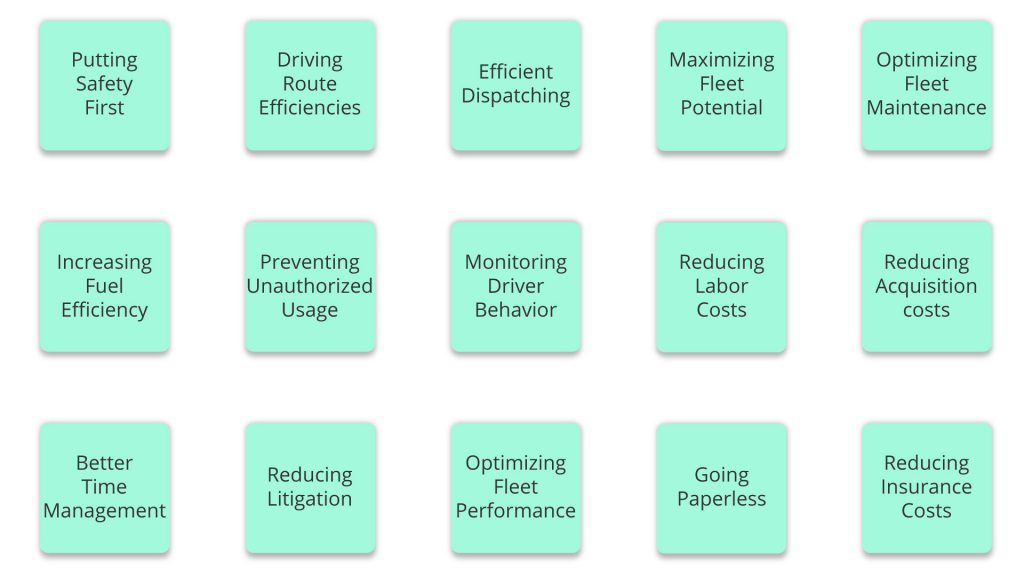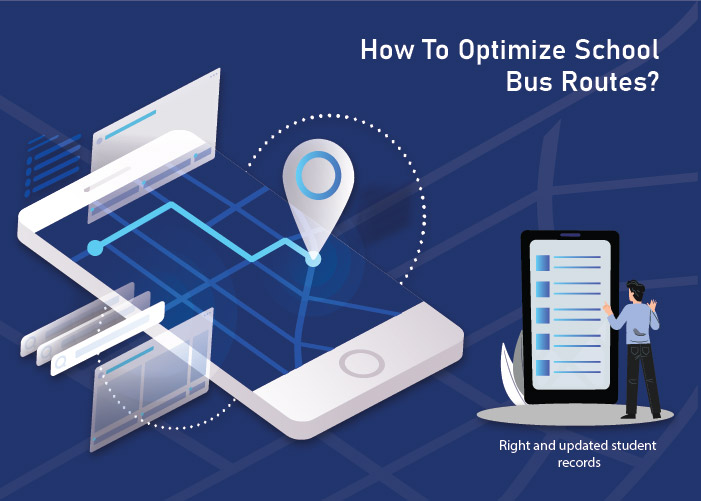School bus transportation is one of the largest expenses for a school, and for most schools, budgets are limited, hence managing an entire fleet of buses becomes a daunting task.
Honestly speaking, without GPS tracking systems, even the most experienced school bus fleet owners would struggle to find ways to reduce costs while still upholding safety and quality standards.
So how exactly do school bus tracking system help in efficient fleet management?

1.Putting Safety First:
Believe it or not – it is the safest fleets that are the most profitable, and therefore the most efficient. If your fleet is unsafe, sooner or later you will find your costs escalating- breakdowns, vehicle damages, medical claims and lawsuits etc.
But a tracking system supports you in putting fleet safety at the top of the priority list:
It provides a means to track school buses in real time and has a system of alerts to notify fleet managers as well as parents and school authorities every time the bus driver exceeds speeding limits or resorts to harsh braking.
The very fact that their driving is monitored makes drivers more conscious of their driving habits. They drive safer because they know they are accountable.
Parents and school authorities get notifications for expected time of arrival (ETA) of the buses. This helps parents to ensure that children are never left unattended at the bus stops, where they might be exposed to various dangers.
The system allows for periodic checks on key safety functionalities like lights, stop arms, cameras, seat belts etc. and raises alerts so that the school buses are never on the road without these safety features fully functioning.
The system helps fleet managers to be proactive about maintenance. It allows for setting up maintenance and servicing schedules and alerts the driver and fleet manager when a service date is approaching. This ensures that buses are safe and road worthy.
Moreover, the system provides a way to monitor student attendance and track their whereabouts using RFID based tracking. This enables the highest level of safety for students and the greatest peace of mind for parents as well as school authorities.
2.Driving Route Efficiencies:
It is practically impossible for school bus fleet operators to manually create and keep track of school bus routes for a single school bus, let alone an entire fleet.
But with a GPS vehicle tracking system in place, the fleet manager needs to simply import student addresses and specify route duration or maximum route time, and the system calculates the most efficient routes that not only save time but also fuel costs. These routing systems are dynamic and flexible to incorporate changes on a day to day basis.
Moreover, the GPS capability also ensures that routes are optimized on the go – so school buses avoid areas with heavy traffic or accidents etc. – which means every day of the week, school buses are plying on the most efficient routes.
3.Efficient Dispatching:
Sometimes buses may breakdown on a given route or there may be a last-minute change that leaves part of the route uncovered. At such times fleet managers can easily view all operating school buses on a map and call in the closest bus to cover the unfinished route.
4.Maximizing Fleet Potential:
The system can ensure that when buses get empty, they are paired with schools nearby so that empty runs / deadheads are avoided as much as possible.
It is also possible to make a case for structuring bell times of schools such that the same set of school buses can ply for multiple schools and bell tiers. This can have a huge impact on savings for schools as well as fleet operators.
5.Optimizing Fleet Maintenance:
Fleets can never ever afford to have downtime – when the buses are down, the over-head costs are still ticking. With the tracking system in place, it is possible to keep a track of downtime for a fleet and investigate factors that could be causing them.
Fleet managers can set up preventive maintenance schedules for necessary checks like oil changes, engine tune ups and tire rotations. These could be set up based on time, mileage or engine hours.
Keeping on top of maintenance ensures that fleet managers avoid the eventuality of major breakdowns or repairs down the line.
6.Optimizing Fleet Performance:
It is possible to periodically monitor the key health parameters of the school bus – engine light status, fuel level, battery voltage, coolant temperature, miles per gallon etc. This enables fleet managers to be on top of things as far as fleet health and fuel economy is concerned.
7.Increasing Fuel Efficiency:
The efficient routing system ensures that travel distance is minimized across the fleet, which results in fuel savings.
Excessive speeding has an adverse effect on fuel economy – by as much as 33%.
But the tracking system provides a system of alerts and feedback, ensuring that drivers rarely ever break the speed limits, and always remain motivated to drive safely.
Similarly, excessive idling is a bane for fuel efficiency, because it has no mileage or revenue attached to it. However, the system helps fleet managers to keep track of idling across the fleet. When the idling time exceeds permissible limits, drivers are sent alerts to correct their driving.
8.Preventing Unauthorized Usage
Personal use of school buses can be a drain for operational efficiency. It increases wear and tear, fuel loss and the risk of accidents and legal liabilities. Here, the system can set up geofence alerts to instantly highlight drivers who deviate from their routes or unscheduled stops. Alerts can also be sent out if the buses are being driven outside of normal hours
9.Monitoring Driver Behavior
Driver negligence is the root cause for most accidents. Tracking systems help to actively monitor drivers for over speeding, hard braking or rash maneuvering. Alert notifications can be sent to all concerned which helps to keep drivers in check.
Fleet managers can also set up a driver scoring system that automatically tracks good as well as bad driving behavior, so that regular defaulters can be trained or counseled, and good performers can be rewarded.
10.Reducing Labor Costs
Maintaining high safety standards helps fleet operators to attract and retain the best drivers – the best talent will flock to the fleets that are the safest.
The system can make a driver’s job simpler with features like guided navigation, two-way communication, streamlined pre and post trip checks, automatic logging of work hours and automated student attendance.
This results in better job performance and satisfaction and better retention rates, which lowers recruitment and training costs.
11.Reducing Acquisition costs
By enforcing better driving practices and preventive maintenance, fleet managers can reduce wear and tear and increase the service life of the school buses. Hence, the cost burden of refurbishing existing school buses or acquiring new ones is greatly reduced.
12.Going Paperless
A cloud-based tracking system can help to digitize and store every aspect of fleet management- from route sheets to personnel files, training documents, payroll, student attendance records etc. This eliminates the need for paper records and makes systems more transparent.
13.Better Time Management
A lot of time gets wasted when parents and school authorities call up the transport manager to check why the bus got delayed and whether the children are safe etc.
But with customized apps for all stakeholders, parents and school authorities can communicate with drivers and transport managers seamlessly. Likewise, teachers can also send out requests to schedule field trips.
14.Reducing Litigation
There could be times when drivers resort to legal action against unpaid wages for over time. Since the tracking system records all driver activity, the relevant data could be easily retrieved from the system as evidence and could form a strong line of defense for fleet managers.
15.Reducing Insurance Costs:
When fleet operators or schools invest in a GPS tracking system, insurance companies know that maintenance checks and driving practices are monitored. Also, school buses become easily traceable in the event of a theft. Hence insurance premiums could get reduced by 15-18%.
Conclusion
Thus, a school bus GPS tracking system not only empowers fleet managers to effectively manage an entire fleet of buses, but also equips them to drive efficiencies, monitor costs and increase profitability – all the while ensuring that the primary goal of child safety is never compromised.
So, what are you waiting for? Call us for a free demo today!


